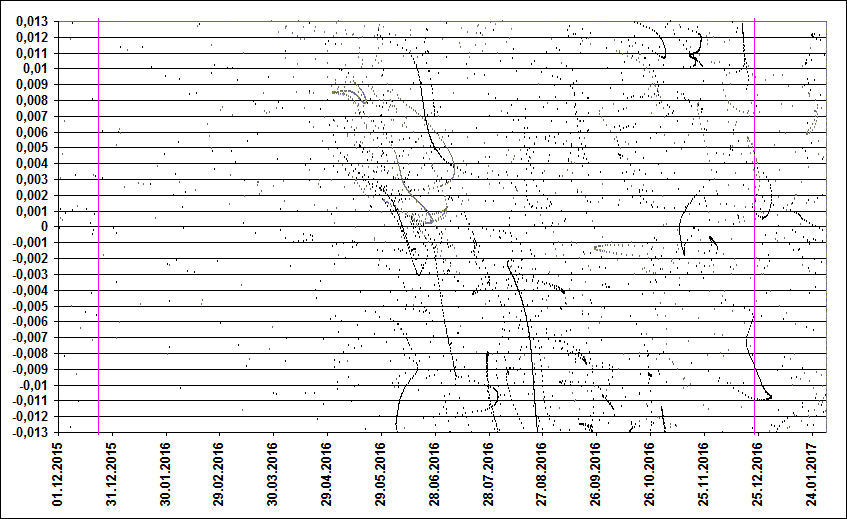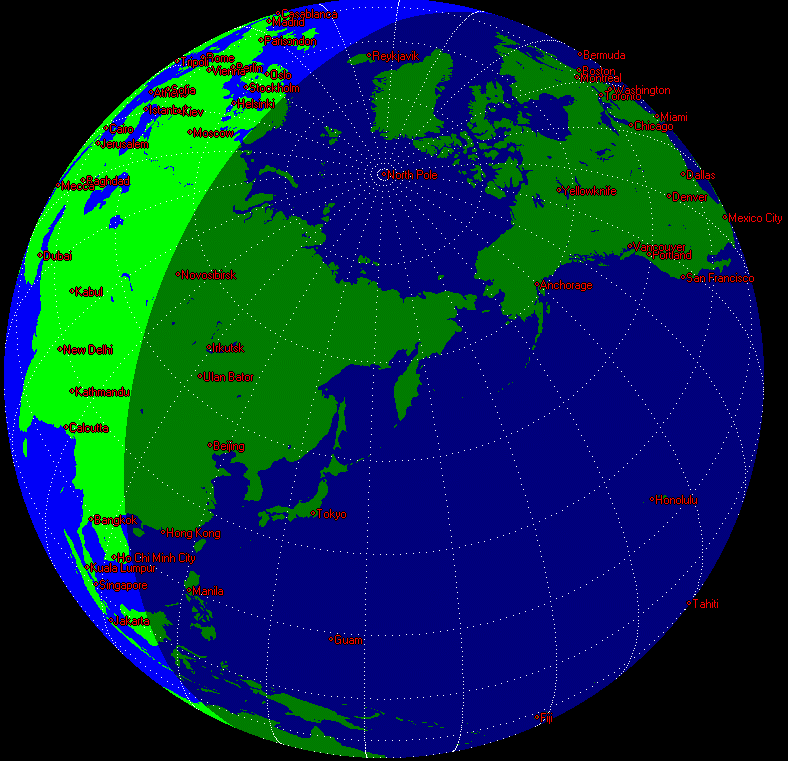Ursids 2016: prediction of activity
to the list of predictions

Fig. 1. Space-temporal projection of Ursid trails parts onto their minimal distance passages in 2016 (correspondence between colours of the particles and their ejection velocities can be seen here).
In 2016 the Earth is expected to pass near a fragment of the old Ursid trail, ejected in 1076. Parameters of the encounter are the following: rD-rE=0.00122 AU, ejection velocity is 11.20 m/s, trail density is 20.4% of that for 1 rev. Leonid trail, computed date and time of maximum is December 22, 10:18 UT.
Estimated activity from this trail is ZHR=15, besides the background activity. This estimation is based on the results of Ursids 2014 outburst, when ZHR reached 50, according to [6]. Considering that in 2016 computed time of maximum lays only one hour from the background maximum, which is expected at 9 UT on 22 December [7], overall shower activity could reach ZHR=25.
In the same time, despite the outburst of 2014, which was caused by much more regular and young 1405 trail, by our computations, in 2016 the level of uncertainty is much higher as 1076 trail is notably elder and perturbed.

Fig. 3. The Earth as seen from coming Ursid meteors (RA=218.8°, Dec=+75.5°) during the expected maximum time of outburst from 1076 trail at 10:18 UT 22 December.
If happens at the given time, this outburst should be visible very well from eastern part the Eurasia (in the local evening time) to north-western part of Northern America (in the evening). The waning crescent Moon in the phase of 0.37 rises in the second half of the night so for evening observations the sky will be moonless, but for morning observers the Moon could be create some troubles.
References
1. "Comet's dust 2.0" program by S. Shanov and S. Dubrovsky. [Used for orbital computations.]
2. Lyytinen E, van Flandern T. "Predicting the strength of Leonid outbursts", 2000, Icarus, P. 158-160.
3. Jenniskens P. Meteor showers and their parent comets, 2006, 780 p. 4. Kasuo Kinoshita, http://jcometobs.web.fc2.com/ [Orbital elements of the comet 8P Tuttle]
5. Hewgill G. Xearth 1.1.0 (Software program), 2003. 6. Molau S. Results of the IMO Video Meteor Network – December 2014. http://www.imonet.org/reports/201412.pdf 7. 2016 Meteor Shower Calendar, http://imo.net/files/data/calendar/cal2016.pdf
References
1. "Comet's dust 2.0" program by S. Shanov and S. Dubrovsky. [Used for orbital computations.]
2. Lyytinen E, van Flandern T. "Predicting the strength of Leonid outbursts", 2000, Icarus, P. 158-160.
3. Jenniskens P. Meteor showers and their parent comets, 2006, 780 p. 4. Kasuo Kinoshita, http://jcometobs.web.fc2.com/ [Orbital elements of the comet 8P Tuttle]
5. Hewgill G. Xearth 1.1.0 (Software program), 2003. 6. Molau S. Results of the IMO Video Meteor Network – December 2014. http://www.imonet.org/reports/201412.pdf 7. 2016 Meteor Shower Calendar, http://imo.net/files/data/calendar/cal2016.pdf